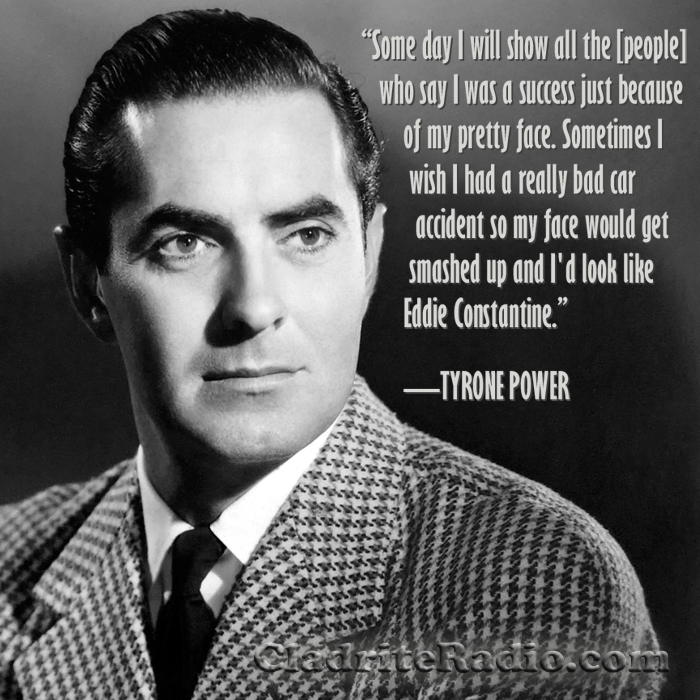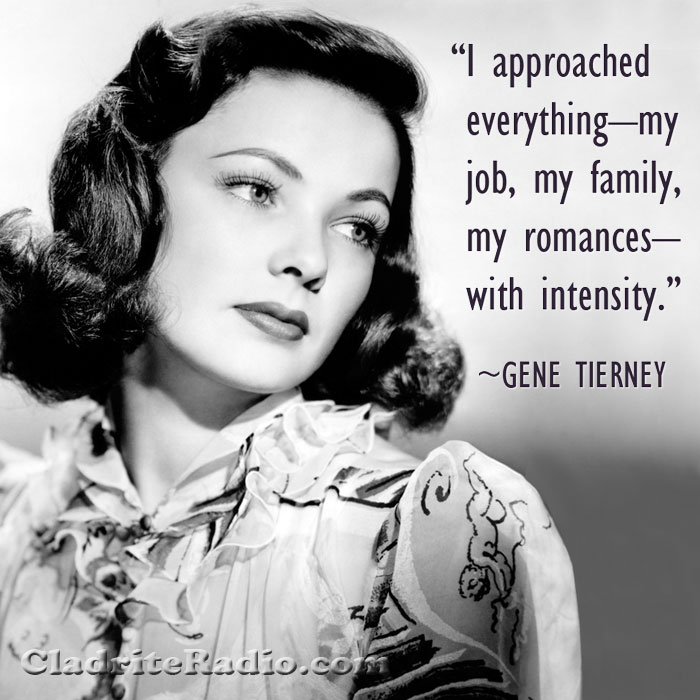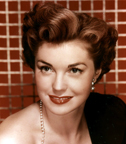Here are 10 things you should know about Tyrone Power, born 109 years ago today. His life and career were too short, but his Hollywood legacy endures.
Tag: Tyrone Power
Remembering Tyrone Power on His Birthday
Tyrone Power was born 108 years ago today in Cincinnati, Ohio. He came from a long line of Tyrone Powers (his great-grandfather was the first of four) and a long line of actors, too, reaching back to the 18th century. Powers kept very busy as an actor on stage and screen (he took a break to serve in World War II), but we think it’s not unfair to suggest that he’s better remembered for his good looks than for his acting work. A quick online search turns up quote after quote from his Hollywood contemporaries commenting on his handsome appearance.
Our favorite Tyrone Power film is perhaps the darkest he appeared in, the 1947 film noir classic, Nightmare Alley, in which he plays a carnival con-man whose life and career are spiraling out of control.
Power died of at age 44 of a heart attack suffered while shooting a dueling scene for Solomon and Sheba (1959). His role had to be recast for that film, though it’s said Power is still visible in certain of the film’s long shots.

Happy 96th Birthday, Gene Tierney!
The lovely Gene Tierney was born 96 years ago today in Brooklyn, New York. Here are GT Did-You-Knows:
- Tierney’s childhood was one of privilege. Her father was a successful insurance broker, her mother a former teacher. She sometimes lived with her grandparents in Connecticut, attending St. Margaret’s School in Waterbury, Connecticut, and the Unquowa School in Fairfield. She later attended finishing schools in Switzerland and Farmington, CT.
- At 17, Tierney visited Los Angeles. Her striking beauty caught director Anatole Litvak‘s eye during a visit to the Warner Brothers studio (her cousin worked there) and she was offered a contract. Her parents urged her to turn it down, due to the low salary and the fact that they envisioned a more high-society path for her.
- Gene Tierney was a debutante, making her society debut in September 24, 1938, but society life didn’t interest her and she resolved to be an actress. She began theatrical studies and was a protégée of Broadway producer-director George Abbott.
- She made her Broadway debut in a small role in What a Life! (1938) that saw her carrying a bucket of water across the stage. A Variety reviewer wrote of her performance, “Miss Tierney is certainly the most beautiful water carrier I’ve ever seen!”
- Tierney went on to appear in a handful of other Broadway shows, garnering larger roles and positive reviews each time. In 1939, she signed a six-month contract with Columbia Pictures and was slated to star in National Velvet (1944), but when the picture was delayed, she returned to Broadway to star in The Male Animal, which was a big hit and led to a contract with 20 Century-Fox and her motion picture debut, in The Return of Frank James (1940), opposite Henry Fonda.
- Tierney wrote poetry throughout her life; she first saw one of poems published in her high school newspaper.
- Tierney struggled with manic depression throughout her adult life. While shooting The Left Hand of God (1955), her costar, Humphrey Bogart, whose sister had struggled with mental illness, urged her to seek medical help.
- Tierney spent time in various institutions and underwent multiple shock treatments against her will. She was thereafter an outspoken critic of shock treatment therapy.
- Tierney was married twice—to fashion designer Oleg Cassini and oil baron W. Howard Lee—and had romantic relationships with many other prominent men, among them John F. Kennedy, Prince Aly Khan and Tyrone Power.
- Tierney, who took up smoking to lower her voice—“I sounded like an angry Minnie Mouse,” she is reported to have said after seeing herself on screen for the first time—remained a heavy smoker throughout her life and died of emphysema in 1999.
Happy birthday, Gene Tierney, wherever you may be!

Esther Williams: A Life Aquatic
 We were sorry to learn that the always lovely Esther Williams has backstroked off to the deep end of the pool at the age of 91.
We were sorry to learn that the always lovely Esther Williams has backstroked off to the deep end of the pool at the age of 91.
So we thought it an apt time to share (once again) with the Cladrite community an interview we did with the divine Ms. Williams some years ago on the occasion of the publication of her memoir, The Million Dollar Mermaid: An Autobiography.
Enjoy! But wait at least an hour after eating before beginning this Q&A.
An Interview with Esther Williams
In the 1940s and ’50s, Esther Williams was one of the brightest stars in MGM’s galaxy. Her movies, with their memorable Busby Berkeley-choreographed aquatic extravaganzas, remain hugely popular today in revival houses and on cable television.
And now, with the publication of her autobiography, Williams shares candid tales of her life as Hollywood’s “Million Dollar Mermaid.” We chatted with Ms. Williams about a wide range of topics, from her husband Fernando Lamas‘s sometimes philandering ways to cross-dressing in Hollywood. It was a conversation as lively and open as her book, The Million Dollar Mermaid: An Autobiography.
As we read your book, it struck us that you’ve have had a life filled with extreme highs and lows. There have been so many wonderful chapters in your life, but so many sad and tragic events as well.
It’s the idea that you’re smiling underwater—doing the impossible!—and then going home to a life that’s unraveling around you…I was struck with it, too. You know, writing your autobiography is therapy. You get in tune with a lot of things you thought you’d forgotten.
Fernando [Lamas] had asked me years ago not to be in the movies or television or do interviews anymore; as I say in my book, he asked, “Can you stop being Esther Williams?” And I said, “Well, that’s an interesting idea; I’ve been her for a lot of years. Let’s see how I do without her.”
And when Fernando died in 1982, the thing I noticed about the death of a life partner, especially one as difficult as Fernando was—when they go, you’re out of a job! The first person that called me after he died was Shirley Maclaine, who is my friend, and she said, “Well, Esther, you can finally get out of the house.” And I thought, Oh, Shirley, you tell it like it is. I’m so very fond of her.
And then Barbara Walters called. And I said, “Oh, Barbara, I haven’t been photographed in 20 years!” The one thing that Katharine Hepburn said that really made sense to me is that good thing about the talk shows is that people get to watch you rot. And I said, “I’ve been rotting in private!” And she said, “I’ve seen you at parties and you don’t look like you’re rotting to me. I want you to come and do one of my specials.” I said, “I’m not going to look good next to Jane Fonda or Sally Field.” And she said, “I won’t put you next to Jane Fonda and Sally Field; I’ll put you in the middle segment—we’ll put Mr. T before you and Howard Cosell after you, two of the ugliest men in the world.” And I said, “Oh, then I’ll do the show—of course!” [laughs]
Early in the book you detail a clinical experience with LSD. Later, you reveal that you were the victim of a rape at the hands of a family friend when you were a young woman, that your older brother died a tragic death when he was just in his teens. Was the book a form of catharsis for you?
You know, we seem to acquire, as we age and deal with various diminished capacities, an ability to articulate our feelings. To say, “No, no, you don’t understand. It wasn’t that way; it was this way.” And what happened to me is that, when I would go through the problems of day-to-day living, it was always wonderful to go to the studio and dive into that wonderful water. The water was very healing for me, and it remains so even today. I’m in my 70s. I had a knee replaced not so long ago and was going through physical therapy, and it hurt, you know? They’ve got to bring the muscles along, and it hurts.
So I said to Mark, my physical therapist—he came to my house to work with me, and he didn’t know how to swim—I said, “You’re $60 an hour, Mark. And you hurt. I don’t want to be hurting anymore; I’m going to get in the pool. And I tell you what we’ll do—we’ll call the $60 a push, because that’s what I’ll charge you for your swimming lesson. And I got him swimming, and he loved it.
What an opportunity for him, to receive a swimming lesson from Esther Williams! That’s a rare opportunity.
I thought it was worth the $60! Candy Bergen rang my doorbell one day and said, “I want [her daughter] Chloe to learn to swim.” And I said, “If you wanted her to learn to play piano, would you ring Artur Rubenstein‘s door?” And she said, “I don’t care if she plays piano, but she’s got to learn to swim.” And I said, “Yes, that’s true. Because that can save her life. Piano won’t ever save her life.”
Are you pleased—or perhaps surprised—by the rise of women’s athletics? Would you ever have imagined the sort of attention that’s been lavished on the U.S. women’s soccer team or the Olympic basketball players and gymnasts?
And synchronized swimming! It’s an Olympic sport now. Yes, it’s very exciting.
Read More »
Splish-Splash: The Esther Williams Interview
The always lovely (even when damp) Esther Williams was the Star of the Month on Turner Classic Movies for May (we say was because, well, the month’s almost over, and her movies were being featured on Thursdays, of which we’ll see no more before the arrival of the hot and sticky month of June).
So we thought it an apt time to share with the Cladrite community an interview we did with the divine Ms. Williams some years ago on the occasion of the publication of her memoir, The Million Dollar Mermaid: An Autobiography.
Enjoy! But wait at least an hour after eating before reading this Q&A.
An Interview with Esther Williams
In the 1940s and ’50s, Esther Williams was one of the brightest stars in MGM’s galaxy and she’s still going strong today. Her movies, with their memorable Busby Berkeley-choreographed aquatic extravaganzas, remain hugely popular today in revival houses and on cable television. And now, with the publication of her autobiography, Williams shares candid tales of her life as Hollywood’s “Million Dollar Mermaid.” We chatted with Ms. Williams about a wide range of topics, from her husband Fernando Lamas‘s sometimes philandering ways to cross-dressing in Hollywood. It was a conversation as lively and open as her book, The Million Dollar Mermaid: An Autobiography.
As we read your book, it struck us that you’ve have had a life filled with extreme highs and lows. There have been so many wonderful chapters in your life, but so many sad and tragic events as well.
It’s the idea that you’re smiling underwater—doing the impossible!—and then going home to a life that’s unraveling around you…I was struck with it, too. You know, writing your autobiography is therapy. You get in tune with a lot of things you thought you’d forgotten.
Fernando [Lamas] had asked me years ago not to be in the movies or television or do interviews anymore; as I say in my book, he asked, “Can you stop being Esther Williams?” And I said, “Well, that’s an interesting idea; I’ve been her for a lot of years. Let’s see how I do without her.”
And when Fernando died in 1982, the thing I noticed about the death of a life partner, especially one as difficult as Fernando was—when they go, you’re out of a job! The first person that called me after he died was Shirley Maclaine, who is my friend, and she said, “Well, Esther, you can finally get out of the house.” And I thought, Oh, Shirley, you tell it like it is. I’m so very fond of her.
And then Barbara Walters called. And I said, “Oh, Barbara, I haven’t been photographed in 20 years!” The one thing that Katharine Hepburn said that really made sense to me is that good thing about the talk shows is that people get to watch you rot. And I said, “I’ve been rotting in private!” And she said, “I’ve seen you at parties and you don’t look like you’re rotting to me. I want you to come and do one of my specials.” I said, “I’m not going to look good next to Jane Fonda or Sally Field.” And she said, “I won’t put you next to Jane Fonda and Sally Field; I’ll put you in the middle segment—we’ll put Mr. T before you and Howard Cosell after you, two of the ugliest men in the world.” And I said, “Oh, then I’ll do the show—of course!” [laughs]
Early in the book you detail a clinical experience with LSD. Later, you reveal that you were the victim of a rape at the hands of a family friend when you were a young woman, that your older brother died a tragic death when he was just in his teens. Was the book a form of catharsis for you?
You know, we seem to acquire, as we age and deal with various diminished capacities, an ability to articulate our feelings. To say, “No, no, you don’t understand. It wasn’t that way; it was this way.” And what happened to me is that, when I would go through the problems of day-to-day living, it was always wonderful to go to the studio and dive into that wonderful water. The water was very healing for me, and it remains so even today. I’m in my 70s. I had a knee replaced not so long ago and was going through physical therapy, and it hurt, you know? They’ve got to bring the muscles along, and it hurts.
So I said to Mark, my physical therapist—he came to my house to work with me, and he didn’t know how to swim—I said, “You’re $60 an hour, Mark. And you hurt. I don’t want to be hurting anymore; I’m going to get in the pool. And I tell you what we’ll do—we’ll call the $60 a push, because that’s what I’ll charge you for your swimming lesson. And I got him swimming, and he loved it.
What an opportunity for him, to receive a swimming lesson from Esther Williams! That’s a rare treat.
I thought it was worth the $60! Candy Bergen rang my doorbell one day and said, “I want [her daughter] Chloe to learn to swim.” And I said, “If you wanted her to learn to play piano, would you ring Artur Rubenstein‘s door?” And she said, “I don’t care if she plays piano, but she’s got to learn to swim.” And I said, “Yes, that’s true. Because that can save her life. Piano won’t ever save her life.”
Are you pleased—or perhaps surprised—by the rise of women’s athletics? Would you ever have imagined the sort of attention that’s been lavished on the U.S. women’s soccer team or the Olympic basketball players and gymnasts?
And synchronized swimming! It’s an Olympic sport now. Yes, it’s very exciting.
Read More »
